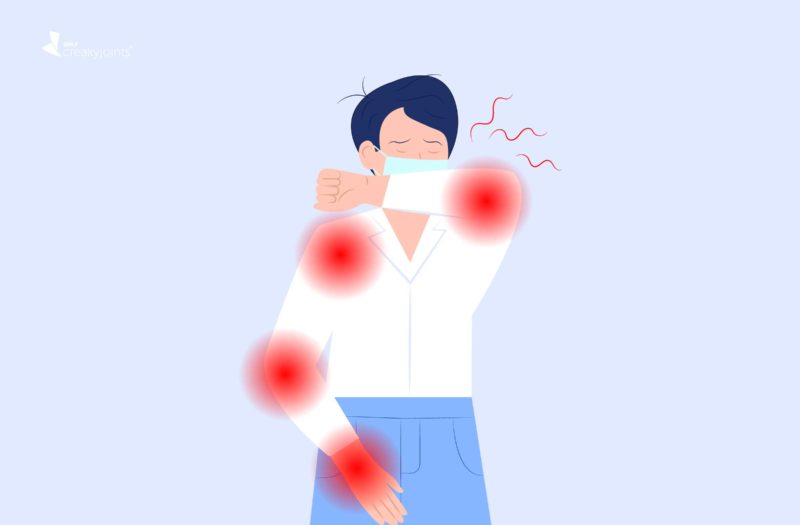Learn more about our FREE COVID-19 Patient Support Program for chronic illness patients and their loved ones.
COVID-19 cases in the United States have been dropping while the number of vaccinated Americans has been rising — two very promising signs. But if you’re immunocompromised, you may be concerned about what other germs may emerge as people stop wearing masks and no longer worry about social distancing.
Although they weren’t always easy to adapt, mitigation efforts during the COVID-19 pandemic helped keep other respiratory viruses at bay. Over the past year, the regular cold and flu season was virtually nonexistent. While there are normally tens of millions of flu cases yearly, there were only a few thousand accounted for in the United States between June 2020 and June 2021, per the U.S. Centers for Disease Control and Prevention (CDC).
But now there are signs that as COVID-19 restrictions loosen, exposure to other kinds of germs is increasing — and making people sick. Experts are already detecting elevated rates of cold viruses and are concerned the flu could follow suit. The case counts of respiratory syncytial virus (RSV), which leads to colds in most people but can cause serious complications in older adults or young children, have been increasing in various places throughout the country in recent weeks. In particular, states such as Minnesota, Louisiana, Texas, and Oklahoma are reporting rare summertime spikes of RSV in children. Experts say they are also seeing small amounts of seasonal flu, metapneumovirus, and other viruses circulating for virtually the first time since the beginning of the pandemic, reports STAT.
This news is especially concerning for immunocompromised people, such as those with inflammatory conditions like rheumatoid arthritis, psoriatic arthritis, and axial spondyloarthritis. In conditions like these, the immune system may be so focused on mistakenly attacking the body that that it may not protect as well against outside threats (like RSVs). A 2012 study published in the journal BMC Musculoskeletal Disorders found that people with rheumatoid arthritis (RA) were more likely to come down with the flu and had a 2.75 times higher chance of complications like pneumonia and stroke than the general population. Additionally, a 2018 study published in the journal Lancet Respiratory Medicine found that severe respiratory infection is the leading reason for intensive care unit (ICU) admission among immunocompromised patients.
It can take immunocompromised people longer to recover from seasonal illnesses that otherwise healthy individuals may recover from quickly.
As the world reopens, it’s crucial that immunocompromised people continue to protect themselves not only against COVID-19, but other potentially serious viruses. Here are five things to keep in mind about the upcoming cold and flu season, and how you can protect yourself if you’re immunocompromised.
1. You May Need to Be Extra Careful Around Small Children
There’s a reason vaccines are so effective: Your immune system is best at defending against types of germs it’s already seen. One of the defenses your body uses against viruses is a memory response that potentially gets boosted when you’re exposed to viruses year after year (even if you aren’t exposed to enough of that virus to actually get sick with symptoms).
“We’ve had a whole year where we haven’t had the same exposure to viruses that we usually do, so there’s a concern that when they come back, our bodies might not be quite as good at fighting them off as usual — and they might spread around a little bit better,” says Ellen Foxman, MD, PhD, an immunologist and Assistant Professor of Laboratory Medicine and Immunobiology at Yale School of Medicine.
This is especially true when it comes to kids. Cold and flu are commonly spread by small children who pass it along to the rest of the family and then the rest of the population. For over a year, many children haven’t been in school or daycare, or around many other people in general.
“We have all the kids born last year and all the kids born this year that haven’t been exposed to very much, so among those children, things might really spread more than usual,” says Dr. Foxman. “Then it spreads to everyone else from there.”
And there is already proof of this happening. When Hong Kong schools reopened after nearly 10 months, there were large outbreaks of acute upper respiratory infections, likely rhinovirus infections (which cause the common cold), per a February 2021 research letter published in Emerging Infectious Diseases.
British researchers observed similar findings: Although there was a drop in all respiratory viruses, including rhinovirus, after the nationwide lockdown in March 2020, there was a sharp increase in the number of detections two weeks after the reopening of state primary and secondary schools in early September, according to a 2020 study published in The Lancet.
The researchers of the U.K. study note that while children are the main drivers of rhinovirus transmission, the subsequent transmission to adults is associated with exacerbations of airways disease and hospitalizations.
If you have small children or grandchildren, be extra careful about reducing your exposure to their germs. For instance, if your grandchildren have colds, it’s best to wait until they recover to see them. Depending on your immunocompromised status, your doctor may also recommend you continue to follow measures like wearing a mask or social distancing.
“Everyone has masks now, so it’s not as big of a deal for everyone to wear one if someone has a cold and their immunocompromised relative is around,” says Dr. Foxman.
Members of the CreakyJoints community seem to share this sentiment. As one member said: “I will wear masks now during cold and flu if we [see] friends or relatives and they have a cold. One blessing from COVID is that masks are okay and we don’t need to be afraid to wear them. I keep extra in my purse now.”
2. Some Viruses May Follow Non-Seasonal Patterns
During the pandemic, we learned that simple mitigation efforts — wearing masks, social distancing, decreasing occupancy in spaces, improving ventilation, and staying home when you’re sick — can prevent respiratory illnesses. But of course, those mitigation efforts are now being dropped by many people, which may affect what we come to expect from the normal seasonal ebb and flow of viruses.
“Right now, we’re seeing a lot more RSV infections than we would normally see at this stage,” says Seema Lakdawala, PHD, Assistant Professor at the University of Pittsburgh School of Medicine in the Department of Microbiology and Molecular Genetics. “A lot of this could just be that everyone is hyper-aware of all symptoms and we weren’t testing at the same capacity before that we are now for all respiratory infections. Perhaps in the future, we’ll see that these viruses have been transmitting in the summer, and we just ignored them because there were fewer or less severe cases.”
Beyond increased testing, however, RSV does appear to be following non-seasonal patterns. In fact, the CDC issued a health advisory to notify clinicians and caregivers about increased interseasonal RSV activity across parts of the southern United States, calling it a “deviation in the typical circulation patterns for RSV.”
The circulation of COVID-19 may also affect the dynamics of other viruses. Although cases of COVID-19 are low right now, SARS-CoV-2 is likely to continue to circulate in some capacity.
“Infection with one virus can impact infection with another virus,” says Dr. Lakdawala. “We know that flu and RSV both circulate in the fall and winter but have distinct peaks, where flu normally follows RSV. It’s likely that with SARS-CoV-2 potentially becoming a seasonal coronavirus, it could shift the dynamics of when we see influenza infections surge and how severe they are.”
In other words, it is not clear how SARS-CoV-2 will impact influenza infections — but it is likely that it could shift when we see the peak of flu season, says Dr. Lakdawala.
3. It’s Important to Get Both COVID-19 and Flu Vaccinations
Although the spotlight is on COVID-19 vaccines this year, remember to get your regular vaccines to protect yourself from what could potentially be a worse flu season.
“For two dangerous viruses, we have safe and effective vaccines — and that’s COVID-19 and influenza,” says Dr. Foxman. “So it’s really worth getting those vaccines.”
The CDC’s Advisory Committee on Immunization Practices (ACIP) recently updated its recommendations to state that flu shots can be co-administered with COVID-19 vaccines in both children and adults. That means you could get the COVID-19 vaccine and another vaccine, like the flu shot, on the same day, per the CDC.
If you have any questions about how effective either vaccine may be for you if you’re immunocompromised, talk to your doctor. Most experts agree that the benefits of vaccines outweigh any potential risks and that some protection is certainly better than none.
The flu vaccine is reformulated each year to target currently circulating strains. But since we essentially “skipped” flu season this past year, experts don’t necessarily know which strains of the flu virus we’ll see predominating next year.
“It’s always difficult to predict what strains are going to circulate, and typically the way we do this is with a lot of surveillance of what’s happening worldwide,” says Dr. Lakdawala. “What happens in the Southern hemisphere tends to be what will happen in the Northern hemisphere. Their peak is usually in July and August and tells us what to expect in our fall seasons — but right now, we really don’t know because we haven’t seen anything yet.”
What we learn in the upcoming months from the Southern hemisphere may provide hints about what our upcoming flu season will look like in the United States. But no matter what strains end up circulating or what formulation of the flu shot is created, it’s still worth it to get vaccinated.
Even though you need a flu shot every year for the most protection, you may get some immunity that carries over to future flu seasons. In fact, there’s some evidence that people who get the flu shot every year have protection against certain flu strains, even when the vaccine strains and a circulating strain in a particular year don’t match. That’s one reason you should get the flu shot even if you’re planning on largely staying in this upcoming flu season — because it could protect you in the future.
4. Get Tested If You Have Symptoms — Even If You’re Vaccinated
Cold, flu, and COVID-19 symptoms can overlap. The CDC says you should still monitor for symptoms of COVID-19, even if you’re fully vaccinated. This is especially true if you’ve been around a sick person. If you have symptoms, get tested and stay home and away from others.
Remember, vaccines — for COVID-19 (and for flu, for that matter) — aren’t 100 percent effective, and you may be at greater risk of contracting the virus if your underlying condition or medications hampered your body’s immune response to the COVID-19 vaccine.
Symptoms of COVID-19 can include:
- Fever or chills
- Cough
- Shortness of breath or difficulty breathing
- Fatigue
- Muscle or body aches
- Headache
- New loss of taste or smell
- Sore throat
- Congestion or runny nose
- Nausea or vomiting
- Diarrhea
If you have COVID-19, it could take you longer to experience symptoms than if you had the flu, according to the CDC. With the flu, a person usually experiences symptoms one to four days after infection. With COVID-19, symptoms typically appear five days after someone is infected, but can appear anywhere from two to 14 days after infection.
5. Standard Mitigation Efforts Help Immunocompromised Patients
There’s no doubt that the protective steps we all implemented during COVID-19 have protected people from various types of respiratory infections. Put simply, without those mitigation efforts, you’re at higher risk of getting sick. What’s more, the CDC says immunocompromised individuals should talk to their health care provider to discuss safe activities, since they may need to continue all precautions to prevent COVID-19.
“If people learn something from this, maybe cold and flu cases won’t come back in greater numbers because our behavior has changed,” says Dr. Foxman. “But if our behavior goes back to the way that it was before, which everyone feels ready for, then we do have a risk of a bigger cold and flu season.”
Of course, experts aren’t recommending that you isolate and never enjoy normal activities again. But if you are immunocompromised and your doctor recommends it, you may find it helpful to continue taking safety measures this year (and into the future).
“Continuing to wear a mask is a great way to decrease the aerosols in which you breathe that might contain different pathogens,” says Dr. Lakdawala. “Trying not to go into very large group settings or poorly ventilated spaces are also great strategies to keep yourself healthy in the context of trying to reduce transmission and infection of other respiratory viruses.”
And of course, don’t forget to continue to wash your hands frequently and carry hand sanitizer with you.
“While contact of contaminated surfaces may be low efficiency in terms of causing an infection, it’s still a mode of transmission,” adds Dr. Lakdawala. “The best way to mitigate that is just by washing your hands often.”
These simple steps can make a big impact. Over the past year, the pandemic has shown us that things that were often considered to be a fact of life (like getting the cold) are preventable.
“We are not powerless against these respiratory viruses,” says Dr. Foxman. “Maybe realizing what a huge impact these simple measures can make will change our culture a bit.”
Get Free Coronavirus Support for Chronic Illness Patients
Join the Global Healthy Living Foundation’s free COVID-19 Support Program for chronic illness patients and their families. We will be providing updated information, community support, and other resources tailored specifically to your health and safety. Join now.
Azoulay E, et al. Acute respiratory failure in immunocompromised adults. Lancet Respiratory Medicine. December 7, 2018. doi: https://doi.org/10.1016/S2213-2600(18)30345-X.
Beu E. Oklahoma doctors see severe spike in RSV cases in babies, children. KOCO News. June 23, 2021. https://www.koco.com/article/oklahoma-doctors-see-severe-spike-in-rsv-cases-in-babies-children/36821267.
Blumentals WA, et al. Rheumatoid arthritis and the incidence of influenza and influenza-related complications: a retrospective cohort study. BMC Musculoskeletal Disorders. August 27, 2012. doi: https://doi.org/10.1186/1471-2474-13-158.
Branswell H. As Covid dissipates in the U.S., cold and flu viruses may return with a vengeance. STAT. May 27, 2021. https://www.statnews.com/2021/05/27/as-covid-dissipates-cold-flu-viruses-return-vengeance-2/.
Ferrando E. ‘Unheard of’ Summer spike in RSV cases in Louisiana children. 4WWL. June 24, 2021. https://www.wwltv.com/article/news/health/unheard-of-summer-spike-in-rsv-cases-in-louisiana-children/289-d1601d79-92a0-41eb-a67b-f3f415b50e5b.
Fong MW, et al. Upper Respiratory Infections in Schools and Childcare Centers Reopening after COVID-19 Dismissals, Hong Kong. Emerging Infectious Diseases. April 22, 2021. doi: https://doi.org/10.3201/eid2705.210277.
Increased Interseasonal Respiratory Syncytial Virus (RSV) Activity in Parts of the Southern United States. Emergency Preparedness and Response. U.S. Centers for Disease Control and Prevention. June 10, 2021. https://emergency.cdc.gov/han/2021/han00443.asp.
Interim Clinical Considerations for Use of COVID-19 Vaccines Currently Authorized in the United States. Vaccines & Immunizations. U.S. Centers for Disease Control & Prevention. July 2, 2021. https://www.cdc.gov/vaccines/covid-19/clinical-considerations/covid-19-vaccines-us.html#Coadministration.
Interview with Ellen Foxman, MD, PhD, an immunologist and Assistant Professor of Laboratory Medicine and Immunobiology at Yale School of Medicine
Interview with Seema Lakdawala, PHD, Assistant Professor at the University of Pittsburgh School of Medicine in the Department of Microbiology and Molecular Genetics
Poole S, et al. Physical distancing in schools for SARS-CoV-2 and the resurgence of rhinovirus. The Lancet. October 22, 2020. doi: https://doi.org/10.1016/S2213-2600(20)30502-6.
Rahming D. Rare summertime RSV cases on the rise in children across Minnesota. Kare 11. June 23, 2021. https://www.kare11.com/article/news/health/rare-summer-rsv-cases-on-the-rise-in-children-across-minnesota/89-1c169e8c-04d5-4f02-9d13-68af4750caa8.
Respiratory Syncytial Virus Infection (RSV). U.S. Centers for Disease Control and Prevention. December 18, 2020. https://www.cdc.gov/rsv/index.html.
Similarities and Differences between Flu and COVID-19. Influenza (Flu). U.S. Centers for Disease Control and Prevention. June 7, 2021. https://www.cdc.gov/flu/symptoms/flu-vs-covid19.htm.
Symptoms of COVID-19. COVID-19. U.S. Centers for Disease Control and Prevention. February 22, 2021. https://www.cdc.gov/coronavirus/2019-ncov/symptoms-testing/symptoms.html.
Weekly U.S. Influenza Surveillance Report. Influenza (Flu). U.S. Centers for Disease Control and Prevention. June 19, 2021. https://www.cdc.gov/flu/weekly/index.htm.
When You’ve Been Fully Vaccinated. COVID-19. U.S. Centers for Disease Control and Prevention. June 17, 2021. https://www.cdc.gov/coronavirus/2019-ncov/vaccines/fully-vaccinated.html.
Woodard T. Summer spike of RSV cases unlike anything North Texas doctors have ever seen. WFAA. June 22, 2021. https://www.wfaa.com/article/news/health/summer-spike-of-rsv-cases-unlike-anything-north-texas-doctors-have-ever-seen/287-5f759c32-74cc-4f09-a87c-fb5b7b10ad74.






